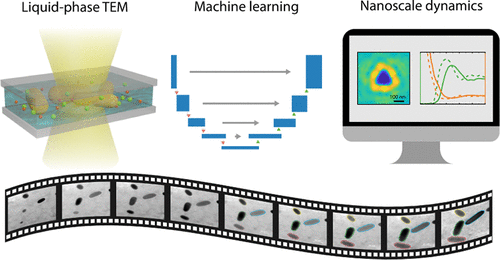当前位置:
X-MOL 学术
›
ACS Cent. Sci.
›
论文详情
Our official English website, www.x-mol.net, welcomes your feedback! (Note: you will need to create a separate account there.)
Machine Learning to Reveal Nanoparticle Dynamics from Liquid-Phase TEM Videos.
ACS Central Science ( IF 18.2 ) Pub Date : 2020-07-06 , DOI: 10.1021/acscentsci.0c00430 Lehan Yao 1 , Zihao Ou 1 , Binbin Luo 1 , Cong Xu 1 , Qian Chen 1
ACS Central Science ( IF 18.2 ) Pub Date : 2020-07-06 , DOI: 10.1021/acscentsci.0c00430 Lehan Yao 1 , Zihao Ou 1 , Binbin Luo 1 , Cong Xu 1 , Qian Chen 1
Affiliation

|
Liquid-phase transmission electron microscopy (TEM) has been recently applied to materials chemistry to gain fundamental understanding of various reaction and phase transition dynamics at nanometer resolution. However, quantitative extraction of physical and chemical parameters from the liquid-phase TEM videos remains bottlenecked by the lack of automated analysis methods compatible with the videos’ high noisiness and spatial heterogeneity. Here, we integrate, for the first time, liquid-phase TEM imaging with our customized analysis framework based on a machine learning model called U-Net neural network. This combination is made possible by our workflow to generate simulated TEM images as the training data with well-defined ground truth. We apply this framework to three typical systems of colloidal nanoparticles, concerning their diffusion and interaction, reaction kinetics, and assembly dynamics, all resolved in real-time and real-space by liquid-phase TEM. A diversity of properties for differently shaped anisotropic nanoparticles are mapped, including the anisotropic interaction landscape of nanoprisms, curvature-dependent and staged etching profiles of nanorods, and an unexpected kinetic law of first-order chaining assembly of concave nanocubes. These systems representing properties at the nanoscale are otherwise experimentally inaccessible. Compared to the prevalent image segmentation methods, U-Net shows a superior capability to predict the position and shape boundary of nanoparticles from highly noisy and fluctuating background—a challenge common and sometimes inevitable in liquid-phase TEM videos. We expect our framework to push the potency of liquid-phase TEM to its full quantitative level and to shed insights, in high-throughput and statistically significant fashion, on the nanoscale dynamics of synthetic and biological nanomaterials.
中文翻译:

机器学习从液相TEM视频揭示纳米粒子动力学。
液相透射电子显微镜(TEM)最近已应用于材料化学,以基本了解纳米级的各种反应和相变动力学。但是,由于缺乏与视频的高噪点和空间异质性兼容的自动分析方法,从液相TEM视频中定量提取物理和化学参数仍然处于瓶颈。在这里,我们首次将液相TEM成像与我们基于基于U-Net神经网络的机器学习模型的定制分析框架集成在一起。我们的工作流程使这种结合成为可能,可以生成模拟的TEM图像作为具有明确定义的地面真实情况的训练数据。我们将此框架应用于三种典型的胶体纳米颗粒系统,关于它们的扩散和相互作用,反应动力学和组装动力学,所有这些都可以通过液相TEM在实时和真实空间中解决。绘制了形状各异的各向异性纳米粒子的各种特性,包括纳米棱镜的各向异性相互作用图,纳米棒的曲率相关和分段蚀刻轮廓以及凹面纳米立方体的一阶链组装的意外动力学定律。这些代表纳米级性质的系统否则无法通过实验获得。与流行的图像分割方法相比,U-Net具有出色的能力,可从高度嘈杂且波动的背景中预测纳米颗粒的位置和形状边界,这是液相TEM视频中常见且有时不可避免的挑战。
更新日期:2020-08-26
中文翻译:

机器学习从液相TEM视频揭示纳米粒子动力学。
液相透射电子显微镜(TEM)最近已应用于材料化学,以基本了解纳米级的各种反应和相变动力学。但是,由于缺乏与视频的高噪点和空间异质性兼容的自动分析方法,从液相TEM视频中定量提取物理和化学参数仍然处于瓶颈。在这里,我们首次将液相TEM成像与我们基于基于U-Net神经网络的机器学习模型的定制分析框架集成在一起。我们的工作流程使这种结合成为可能,可以生成模拟的TEM图像作为具有明确定义的地面真实情况的训练数据。我们将此框架应用于三种典型的胶体纳米颗粒系统,关于它们的扩散和相互作用,反应动力学和组装动力学,所有这些都可以通过液相TEM在实时和真实空间中解决。绘制了形状各异的各向异性纳米粒子的各种特性,包括纳米棱镜的各向异性相互作用图,纳米棒的曲率相关和分段蚀刻轮廓以及凹面纳米立方体的一阶链组装的意外动力学定律。这些代表纳米级性质的系统否则无法通过实验获得。与流行的图像分割方法相比,U-Net具有出色的能力,可从高度嘈杂且波动的背景中预测纳米颗粒的位置和形状边界,这是液相TEM视频中常见且有时不可避免的挑战。



























 京公网安备 11010802027423号
京公网安备 11010802027423号